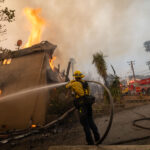When Hurricane Helene barreled across several southern states last fall, it destroyed homes and killed more than 150 people. The storm also took out one of the country’s main factories producing intravenous fluid bags widely used in hospitals.
The ensuing shortage forced manufacturer Baxter International Inc. to ration supplies and hospitals to use fewer IV bags, illustrating the risks that climate change poses to the pharmaceutical supply chain.
Nearly two-thirds of US drug production facilities are located in areas that have had a major disaster like a fire or hurricane in recent years, according to a new study published in the peer-reviewed journal JAMA on Wednesday. The paper concluded that plants across the drug supply chain, from those that manufacture active pharmaceutical ingredients to packaging facilities, risk disruption as climate change ups the odds of extreme weather.
These threats are especially pressing as the Trump administration makes a push to ramp up US drug manufacturing, say the authors of the new research. As part of a broader effort to increase US pharmaceutical factories, President Donald Trump has threatened to impose tariffs on imported medicines, a move that could make the country more reliant on domestically produced supplies. Roughly 40% of finished medications and 80% of active pharmaceutical ingredient components come from abroad, according to US Food and Drug Administration estimates.
“Climate change-driven extreme weather events impose new threats to established vulnerabilities in the US drug supply,” the study’s authors wrote. “Those threats must be examined to be appropriately mitigated.”
Related: Coastal Communities Restoring Natural Defenses Against Storm Surges, Rising Seas
The analysis used FDA and Federal Emergency Management Agency databases to find drug production facilities in counties with major fire, hurricane, storm, tornado and flood events between 2019 and 2024. California, Florida and North Carolina were home to the largest numbers of facilities in counties with presidential disaster declarations.
Hurricanes were the most common of the climate-related disasters in areas with pharmaceutical facilities, according to the research.
In 2017, Hurricane Maria hit Puerto Rico and disrupted Baxter’s saline solution manufacturing facility there. Baxter is a major manufacturer of the sterile salt water widely used in hospitals to deliver medications and keep patients hydrated. The company didn’t have backup facilities manufacturing smaller bags of the saline solution, which compounded pre-existing supply issues. Baxter has said it’s learned from Maria and now has a more resilient supply chain, citing manufacturing investments and FDA clearance to produce saline outside of the US if needed.
Even resilient supply chains are prone to climate shocks, though. Helene flooded Baxter’s North Carolina facility, which made 60% of the IV fluid bags used in US hospitals for various functions, including to deliver medicine. Baxter reported earlier this year that the North Carolina plant was back at pre-hurricane production levels, and the FDA said this month that the shortages had resolved.
Sarah Ryan, a spokesperson for pharmaceutical industry group PhRMA, says that the industry works with government regulators to avoid shortages.
The new research did not determine how often such disasters result in shortages, saying that data wasn’t readily available.
Was this article valuable?
Here are more articles you may enjoy.


 Poorer Americans Dropped Federal Flood Insurance When Rates Rose
Poorer Americans Dropped Federal Flood Insurance When Rates Rose  Hacking Group ‘ShinyHunters’ Claims Theft of Data From Users of Pornhub
Hacking Group ‘ShinyHunters’ Claims Theft of Data From Users of Pornhub  Catastrophe Bonds Linked to Wildfires Lose ‘Untouchable’ Status
Catastrophe Bonds Linked to Wildfires Lose ‘Untouchable’ Status  Court Awards $32 Million Over Premature Baby’s Death at Yale Hospital
Court Awards $32 Million Over Premature Baby’s Death at Yale Hospital 

